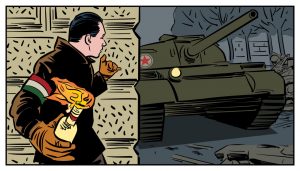Drowning the revolution in blood
At 4 o’clock in the morning, November 4, 1956, the Soviet forces launched their attack on the Hungarian capital under the direct authority of General Vasily Kazakov as part of Operation Whirlwind in order to bring about an end to the revolution. A counter-government led by János Kádár was formed in Szolnok, while Prime Minister Imre Nagy’s declaration was broadcast on the radio:
“This is Imre Nagy speaking, the president of the Council of Ministers of the Hungarian People’s Republic. Today at dawn, Soviet troops attacked our capital with the obvious intention of overthrowing the legal, democratic Hungarian government. Our troops are in combat. The government is at its post. I notify the people of our country and the entire world of this fact.”
Lieutenant General Kuzma Grebennik of the Soviet Army attacked Budapest with five units, who encountered fierce resistance from the revolutionary groups and national guard.
The lads of Pest, who had taken up arms following October 23, resumed the fight the morning of November 4 and returned to their stations. There were fierce scenes within Budapest at locations such as Széna Square, Baross Square, Corvin Lane, as well as Soroksár and Pesterzsébet. Bitter fighting also commenced in the countryside in cities such as Pécs, Miskolc, Keszthely and Sztálinváros (today Dunaújváros).
Although the situation of the armed youth fighting with guns and Molotov cocktails against the Soviet armored units and artillery was hopeless, they nonetheless fought heroically for days. The Soviets would not be allowed to simply waltz in and take control. The final struggles lasted a week, holding out the longest in Újpest and Csepel. More than 700 Soviet soldiers lost their lives in the fighting and 1,540 troops were injured.
On November 11th, Imre Nagy, who had taken refuge at the Yugoslav Embassy, was formally relieved of his post as prime minister. With this, the restoration of the Soviet-style dictatorship led by János Kádár commenced, which would result in one of the bloodiest reprisal periods in Hungarian history.
Ajtony Virágh
